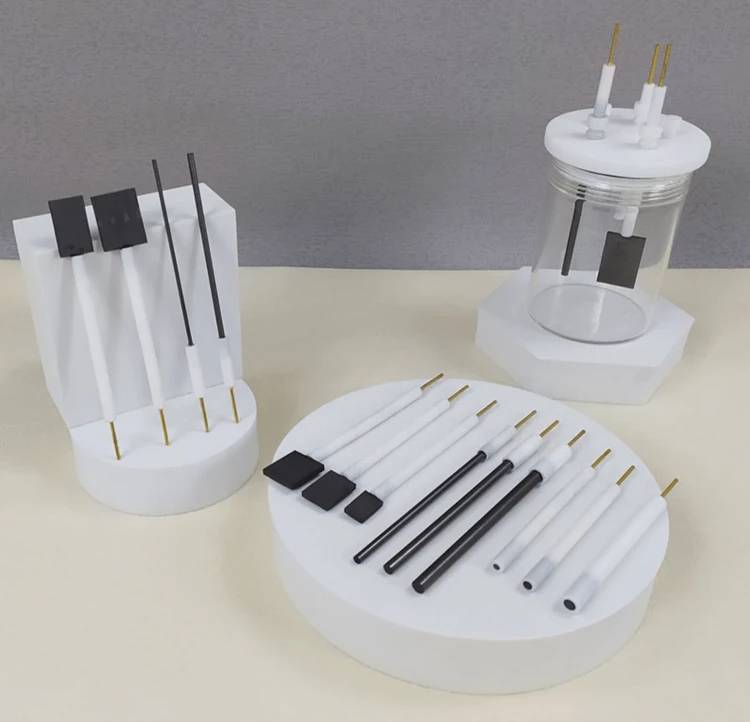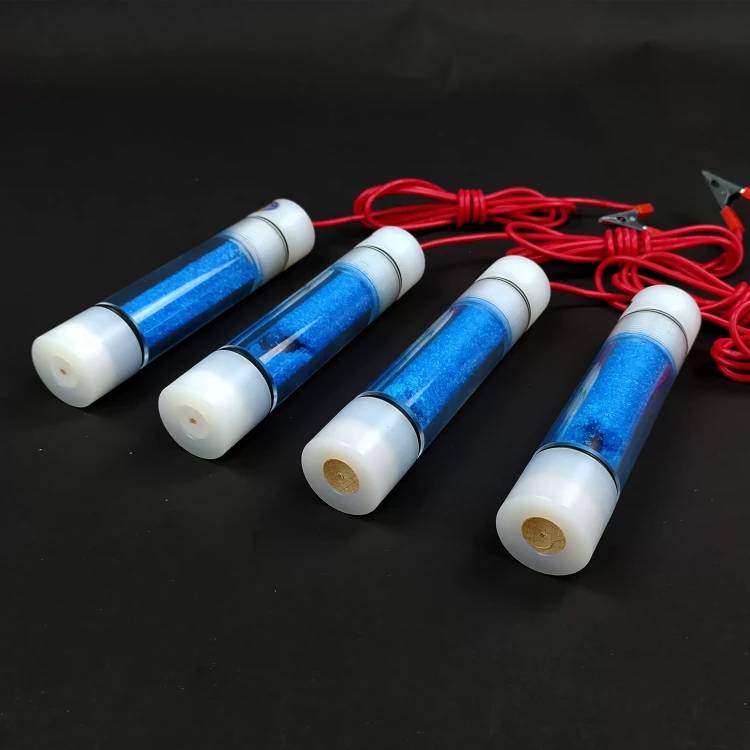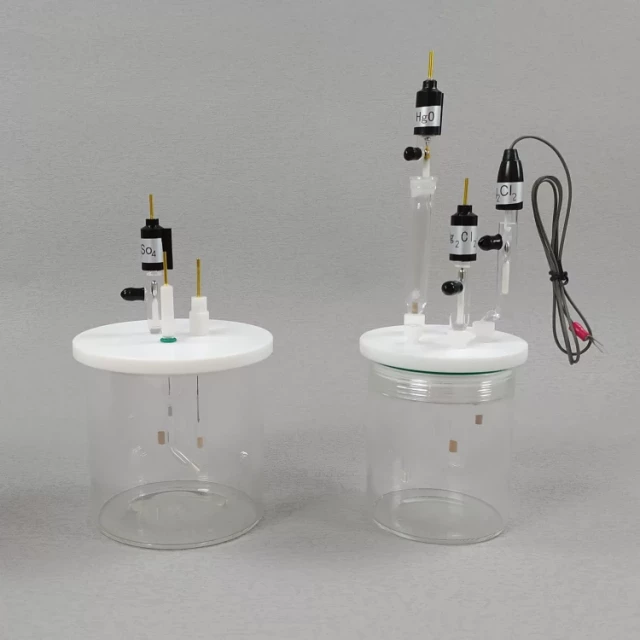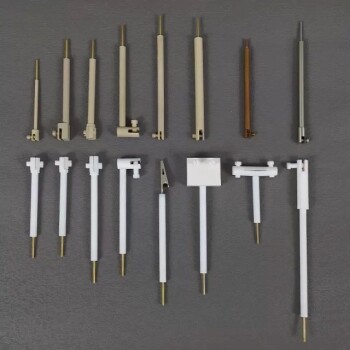Introduction to Ag/AgCl Reference Electrode
Ag/AgCl reference electrode is a widely used reference electrode due to its stable potential and long-term stability. It consists of a silver wire coated with silver chloride, which is immersed in a solution containing chloride ions. The electrolyte solution used in the electrode is critical in determining its performance. The Ag/AgCl electrode is commonly used in electrochemical analysis such as pH measurement, potentiometry, and cyclic voltammetry. It is preferred over other reference electrodes due to its low cost, easy preparation, and reproducibility.
Table of Contents
- Introduction to Ag/AgCl Reference Electrode
- The Structure of Ag/AgCl Electrode
- The Working Principle of Ag/AgCl Electrode
- Half-cell reaction of Ag/AgCl electrode
- How to Choose the Right Fill Solution
- Applications of Ag/AgCl electrode in electrochemical analysis
- Comparison with Other Reference Electrodes
- Conclusion and Future Prospects
The Structure of Ag/AgCl Electrode

The Ag/AgCl reference electrode is a popular and widely used electrode in electrochemical measurements. Its structure is simple, yet effective, consisting of a silver wire coated with a layer of silver chloride. The electrode works based on the redox reaction between Ag and AgCl, which acts as a reversible redox couple. The electrode potential is determined by the concentration of Ag+ ions in equilibrium with AgCl and is dependent on the solution's chloride ion activity.
The structure of the Ag/AgCl reference electrode consists of a silver wire with a silver chloride dip, surrounded by a salt electrolyte. The salt is usually potassium chloride (KCl) which has been saturated in silver chloride to ensure the silver chloride dip does not become stripped. In order for a reference electrode to work, a small amount of the internal fill solution will leak from the sensor to the sample, which provides electrical contact and a stable, unchanging potential. This leak path is through the electrode junction, which can be made from a range of materials including ceramic, cotton, teflon and more.
The fill solutions should always be selected according to the requirements of the application, so that it does not interact with the sample or cause an error in measurement (such as if it acts as an interfering ion in ISE analysis). The Ag/AgCl reference electrode provides 199mV (±5mV) versus a normal hydrogen electrode if surrounded by saturated KCl/AgCl solution measured at 25°C.
The electrode potential remains stable because AgCl is an insoluble salt, and the Ag+ concentration is determined by the activity of chloride ions in the solution. Both the SCE and the Ag/AgCl reference electrodes offer stable half-cell potentials that do not change over time. Only a slight temperature dependence of the potential is observed in these electrodes, changing by approximately 0.5 – 1.0 mV/oC. The loss of electrolyte to evaporation does not change the saturated nature of the solution, nor the potential.
One must be aware that the contact junctions of the half cells by nature slowly leak fill solution into the external solution in which they are found. For instance, a small amount of soluble AgCl2-1 ion in the internal KCl solution of the Ag/AgCl reference can find its way into the analyte solution over time, where it can lead to silver deposition on the working electrode at relatively low applied potentials. Therefore, a double-junction design can reduce the problem of contamination by placing a second solution between the reference half cell and the measurement solution.
In many applications, even a small amount of electrolyte solution leaking from the reference electrode can immediately compromise the electrochemical reactions occurring in the analyte solution. Primary among these applications is non-aqueous electrochemistry. In these applications, it may be possible to use what is called a pseudo-reference electrode. The simplest pseudo-reference electrode is a metal wire, like platinum, inserted directly into the analyte solution.
Reference electrodes come in a variety of shapes. While it is theoretically possible to use Ag wire dipped directly into the analyte solution as a reference electrode for the simplest of CVs, it should be avoided because the slow loss of Ag+ ions may interact with the analyte and any changes in the electrolyte solution (from added substrate, for example) may change the reference potential measured at the Ag wire. The best practice is to isolate the reference electrode from the analyte solution using a vycor (porous glass) frit, which maintains electrical contact while minimizing solution mixing.
Care must be taken to prevent the vycor frit from drying out, which causes the electrolyte salt to crystallize in the pores and render it unusable. The integrity of a vycor frit can be tested by attempting to squeeze liquid through it using a pipette bulb; if fluid filters though easily, the vycor frit should be replaced.
Commercially available aqueous Ag/AgCl reference electrodes should be stored in the dark and submerged in solutions that are identical to the solution inside the reference electrode, usually saturated KCl. “Old” Ag/AgCl electrodes can develop a white buildup on the wire, and may drift away from their advertised reference potential. It is best to use a reference compartment solution that contains the same solvent as the electrolyte salt concentration to avoid complications and contamination, so aqueous reference electrodes should not be used for non-aqueous experiments.
For non-aqueous electrochemical experiments, a reference electrode can be made easily from commercially available (or recycled) glass reference electrode compartments, vycor frits, and silver wire. As in the case of aqueous reference electrodes, the silver wire should be submerged in a solution of the same solvent that has the same concentration of electrolyte salt (preferably using the same salt) as the solution containing the analyte.
The Working Principle of Ag/AgCl Electrode
AgAgCl reference electrodes are widely used in various fields of electrochemistry as a standard reference for measuring electrochemical potentials. The working principle of the Ag/AgCl electrode is based on the concept of a half-cell reaction, which involves the transfer of electrons between the electrode and the electrolyte.
Half-cell Reaction
The electrode consists of a silver wire coated with silver chloride, which functions as an electrolyte. In this case, the silver wire acts as the anode, while the silver chloride coating acts as the cathode. When the electrode is immersed in an electrolyte solution, a redox reaction occurs, where the silver chloride on the surface of the electrode is reduced to form silver ions and chloride ions.
Redox Reaction
The silver ions then react with the silver wire to form metallic silver, while the chloride ions remain in the electrolyte. This reaction creates a potential difference between the electrode and the electrolyte, which can be measured using a voltmeter.
Applications
AgAgCl reference electrodes are commonly used in electrochemical experiments, such as in the measurement of pH and the determination of oxidation-reduction potentials. They are also used in various processes, such as in the electroplating of metals and in the production of chlorine gas. The accuracy and reliability of AgAgCl reference electrodes make them an essential tool in the field of electrochemistry, providing researchers and scientists with precise measurements that are crucial in understanding chemical reactions and processes.
Half-cell reaction of Ag/AgCl electrode
The AgAgCl electrode is widely used as a reference electrode in electrochemical studies due to its stable and reproducible electrode potential reference. The AgAgCl electrode works on the principle of a half-cell reaction, where the reduction of silver ions (Ag+) to silver metal (Ag) takes place at the electrode surface, while chlorine ions (Cl-) are released into the solution.
The half-cell reaction of the AgAgCl electrode is represented as Ag+ + e- → Ag and Cl- → ½ Cl2 + e-. At the electrode surface, silver ions are reduced to silver metal by accepting an electron. This electron is provided by the external circuit connected to the working electrode. As a result of this reduction reaction, silver metal is deposited on the electrode surface.
On the other hand, chlorine ions are oxidized to form chlorine gas and release an electron. This electron flows into the external circuit and completes the circuit. The release of chlorine ions into the solution maintains the ionic balance of the solution.
The half-cell potential of the AgAgCl electrode is +0.197 V vs. the Standard Hydrogen Electrode (SHE) at 25°C. This potential is the result of the equilibrium between the oxidation and reduction reactions taking place at the electrode surface.
The AgAgCl electrode potential is independent of the solution composition and temperature. This makes it an ideal reference electrode for measuring the potential of other electrodes in electrochemical studies. The reference electrode potential is defined as the difference between the electrode potential of the working electrode and the electrode potential of the reference electrode.
In summary, the half-cell reaction of the AgAgCl electrode involves the reduction of silver ions to silver metal and the oxidation of chlorine ions to chlorine gas. The electrode potential is stable and independent of the solution composition and temperature. This makes it an ideal reference electrode for measuring the potential of other electrodes in electrochemical studies.

How to Choose the Right Fill Solution
The choice of the fill solution for an AgAgCl reference electrode is critical to ensure accurate and reliable measurements. It depends on the specific application, the type of sample being measured, and the required accuracy and precision. Here are the steps to choose the right fill solution:
Step 1: Consider the Sample
The first step in choosing the right fill solution is to consider the sample being measured. If the sample contains silver ions, it is not recommended to use a reference electrolyte containing chloride ions. In such cases, liquid junction potentials can be used to provide a stable potential without exposing the sample to a reference electrolyte containing chloride ions.
Step 2: Determine the Required Accuracy and Precision
The second step is to determine the required accuracy and precision of the measurements. Different fill solutions can affect the stability, response time, and accuracy of the measurements. For example, in seawater measurements, potassium chloride is preferred due to its similarity to the chloride concentration in seawater. Sodium chloride is commonly used in biological and environmental applications due to its biological compatibility and low toxicity. Calcium chloride is used in measurements of concentrated electrolytes, as it provides a higher ionic strength and reduces the potential for interferences from other ions.
Step 3: Choose the Right Fill Solution
The third step is to choose the right fill solution based on the specific application and type of sample being measured. For example, if the sample is a biological sample, sodium chloride is recommended. If the sample is a seawater sample, potassium chloride is the preferred choice. If the sample is a concentrated electrolyte, calcium chloride is recommended.
Step 4: Consider Other Factors
Other factors such as the temperature, pH, and concentration of the sample should also be considered when choosing the right fill solution. The fill solution should neither react with, nor contaminate the sample. The diffusion rates of both the cations and anions of the filling solution's electrolyte should be as close to equal as possible.
In summary, choosing the right fill solution for an AgAgCl reference electrode requires careful consideration of the specific application, the type of sample being measured, and the required accuracy and precision. A liquid junction potential may be used if the sample cannot be exposed to a reference electrolyte containing chloride ions. By following these steps, researchers and technicians can optimize the performance of their electrochemical measurements.
Applications of Ag/AgCl electrode in electrochemical analysis
The Ag/AgCl electrode is an essential tool in electrochemical analysis, and its applications are numerous. The stable and reproducible potential of the electrode makes it the preferred choice for many electrochemical experiments. Some of the applications of Ag/AgCl electrodes in electrochemical analysis are discussed below.
Potentiometric titration
Ag/AgCl electrodes are widely used in potentiometric titration experiments. They are used to measure the concentration of a particular substance in a solution. The Ag/AgCl electrode is used as a reference electrode, while the working electrode is used to measure the potential of the solution. The potential difference between the two electrodes is proportional to the concentration of the substance being measured.
Ion-selective electrode
Ion-selective electrodes are used to measure the concentration of specific ions in a solution. Ag/AgCl electrodes are commonly used as reference electrodes in ion-selective electrode experiments. This is because the potential of the Ag/AgCl electrode is stable and reproducible, making it an ideal reference point for the measurement of ion concentration.
pH measurement
Ag/AgCl electrodes are also commonly used in pH measurement experiments. They are used as reference electrodes, while a glass electrode is used as the working electrode. The potential difference between the two electrodes is proportional to the pH of the solution being measured.
Environmental analysis
The Ag/AgCl electrode is widely used in environmental analysis, such as monitoring water quality and soil analysis. They are used to measure the concentration of ions in a solution, which can indicate the presence of contaminants or pollutants. The stable and reproducible potential of the Ag/AgCl electrode make it an ideal tool for environmental analysis.
Chemical and pharmaceutical industries
In the chemical and pharmaceutical industries, Ag/AgCl electrodes are used to monitor the progress of chemical reactions and to measure the concentration of specific substances in a solution. They are also used to control the pH of solutions during chemical reactions.
In conclusion, the Ag/AgCl electrode is a vital component in electrochemical analysis. Its stable and reproducible potential make it an essential tool for many electrochemical experiments. The applications of Ag/AgCl electrodes are widespread and diverse, including in the chemical, pharmaceutical, and food industries, as well as in environmental analysis.
Comparison with Other Reference Electrodes
AgAgCl reference electrode has several advantages over other types of reference electrodes, including its stability, reproducibility, and ease of use. However, other types of reference electrodes also have their own advantages and limitations.
Saturated Calomel Electrode (SCE)
SCE is a widely used reference electrode that has a mercury-mercurous chloride (Hg-Hg2Cl2) system, which is in contact with a saturated potassium chloride (KCl) solution. The electrode potential of SCE is +0.242 V vs. the standard hydrogen electrode (SHE) at 25°C. It is known to be stable, reproducible, and has a low resistance. However, it has some disadvantages, such as the potential for mercury contamination, the need for careful handling due to its toxicity, and its sensitivity to temperature changes.
Standard Hydrogen Electrode (SHE)
SHE is a reference electrode that has a platinum electrode in contact with a solution of 1 M HCl and a hydrogen gas pressure of 1 atm. The electrode potential of SHE is defined as 0 V at all temperatures. It is known to be stable, reproducible, and has a well-defined potential, which makes it an ideal reference electrode. However, it has some disadvantages, such as the difficulty in preparing and maintaining the hydrogen gas and the need for a separate reference electrode to measure the potential of the cell.
Copper-Copper Sulfate Electrode
Copper-copper sulfate electrode is a reference electrode that has a copper wire in contact with a solution containing copper sulfate. The electrode potential of copper-copper sulfate electrode is +0.339 V vs. SHE at 25°C. It is known to be stable, reproducible, and has a low resistance. However, it has some disadvantages, such as the potential for copper contamination and the need for careful handling due to its toxicity.
pH Electrode
pH electrode is a reference electrode that measures the potential difference between a glass electrode and a reference electrode. The reference electrode used in pH measurements is usually a saturated calomel electrode or a silver-silver chloride electrode. The pH electrode is used to measure the pH of a solution accurately. However, it has some limitations, such as its sensitivity to temperature changes and the need for regular calibration.
Overall, the choice of reference electrode depends on the specific requirements of the measurement and the properties of the solution being studied. AgAgCl reference electrode is a widely used reference electrode that has several advantages over other types of reference electrodes, including its stability, reproducibility, and ease of use. However, other types of reference electrodes also have their own advantages and limitations.
Conclusion and Future Prospects
In conclusion, the Ag/AgCl reference electrode is widely used in electrochemical analysis due to its stable and reproducible potential. The half-cell reaction of Ag/AgCl electrode is well understood, and the choice of fill solution is critical for its performance. Although other reference electrodes are available, the Ag/AgCl electrode is preferred due to its simplicity and low cost. In the future, advancements in material science and nanotechnology may lead to the development of more efficient and cost-effective reference electrodes for electrochemical analysis.
Related Products
- Reference Electrode Calomel Silver Chloride Mercury Sulfate for Laboratory Use
- Electrode Fixture for Electrochemical Experiments
- Copper Sulfate Reference Electrode for Laboratory Use
- Electrolytic Electrochemical Cell for Coating Evaluation
- Gold Electrochemical Sheet Electrode Gold Electrode
Related Articles
- Comprehensive Guide to Reference Electrodes: Types, Applications, and Selection Criteria
- How to Make Your Own Ag/AgCl Reference Electrode for Electrochemical Experiments
- A Beginner's Guide to Understanding Reference Electrodes in Electrochemistry
- Electrochemical Electrodes in Chemical Analysis
- How to Choose the Right Reference Electrode for Your Application














